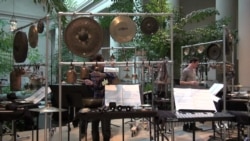Sometimes you can feel the ring of a bell from your head to your feet. Take that idea and expand it and you may have an idea of what American composer Augusta Read Thomas has done. It is called “Resounding Earth” where different metals and over 100 bells from a wide mix of cultures and historic periods are used to create music.
Award-winning American composer Thomas says this is the sound of the Earth.
"I have been always attracted to bell-like sounds. The title “Resounding Earth”. Resounding Earth on the one hand, we are talking about resounding earth. The earth is full of metals that all of mankind has turned into instruments. We are going to play them from all around the world together on one stage."
Augusta Reed Thomas says her composition is like a United Nations of resonances.
"These are Indian Noah bells or Khadki."
On a recent Sunday, the members of Third Coast Percussion were setting up the instruments to practice “Resounding Earth.” The Chicago-based group was invited to perform the piece at the National Gallery of Art in Washington.
Peter Martin is one of the four musicians.
“We have bells that come from India, we have gongs that come from Thailand. We have other bells that come from all over the European continent. Literally every continent, I believe, is represented in the instrumentation."
Some are locally found objects.
"It is a spring coil from heavy machinery; makes beautiful sound. It is not built to be a musical instrument but makes beautiful sound."
All together, “Resounding Earth” includes over 350 metal objects, ranging from tiny cluster bells to huge Chinese gongs.
Augusta Reed Thomas developed the piece while working with the Third Coast percussionists.
"It was very challenging just being able to figure out the distinctive sound qualities of each one of the instruments and to be able to play them in a way to balance them across each other. That was both difficult for ourselves as performers but also for the composer herself who was trying to craft the piece."
Peter Martin says the 35-minute opus –- piece of music was many years in the making, and every move of the players was carefully planned.
The work has four movements. One is scored, or musically written, just for the 26 Japanese rins or singing bowls, creating a restful, thoughtful sound.
Eighteen Burmese spinning bells, traditionally played by monks, are a central part of another movement.
"It's also re-sounding earth to take what is in the earth and re-sound it. And in that sense, it is really giving it back to the earth, giving it back to the people. It has been a very beautiful journey."
The composer and the players say they would love to take the music to all the places where the bells were made and share their sound with people around the world.
I’m Marsha James.
June Soh reported this story from Washington. Marsha James wrote it for VOA Learning English. Caty Weaver was the editor.
_____________________________________________________________
Words in This Story
resounding – adj. producing a loud, deep sound that lasts for a long time
composition– n. the way in which something is put together or arranges
gong – n. a large metal disc that makes a deep ringing sound when it is struck with a padded hammer
distinctive – adj. having a quality or characteristic that makes a person or thing different from others
opus - n. a piece of music written by a major composer
score – v. to write or arrange music for a specific performance





